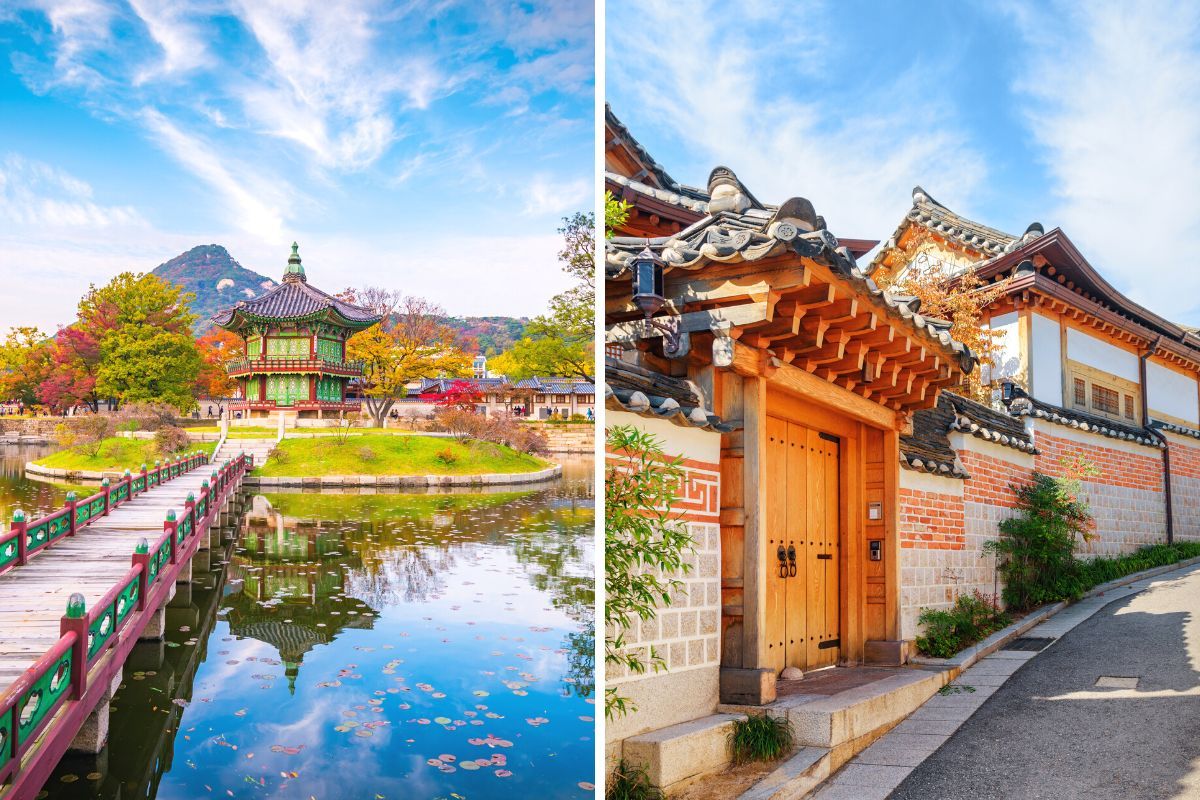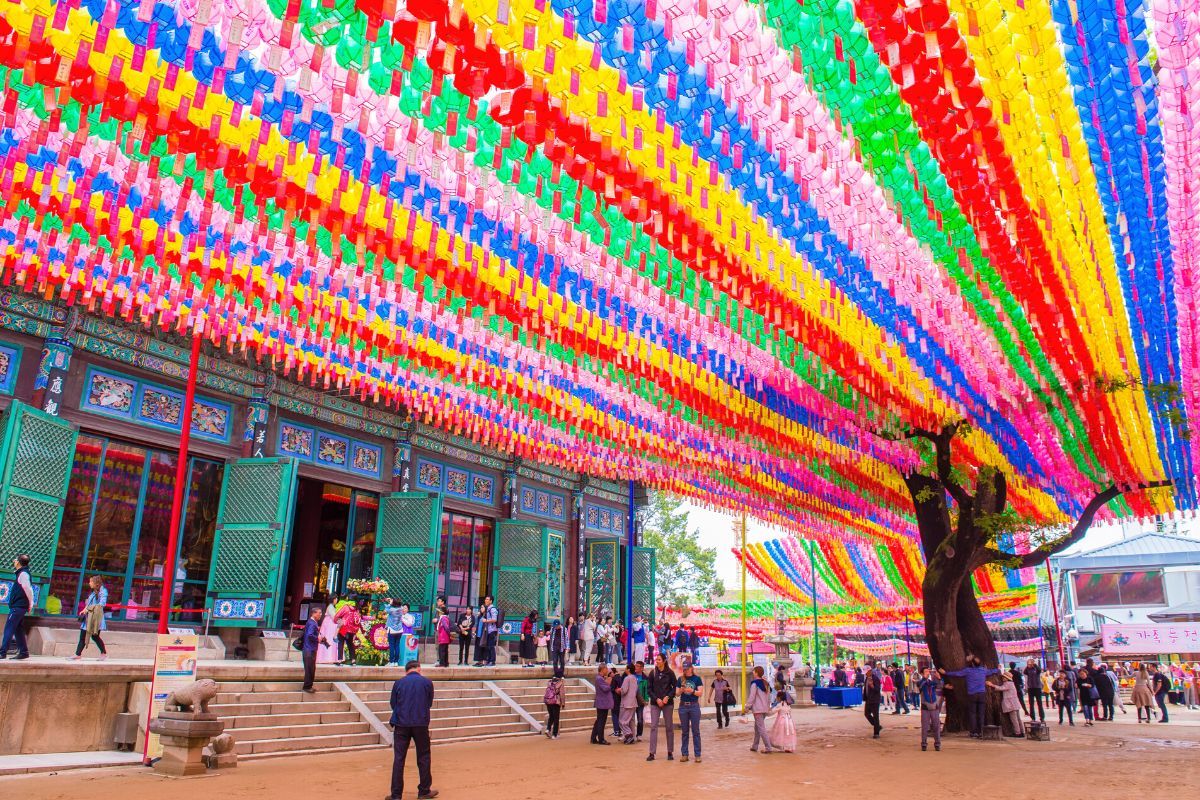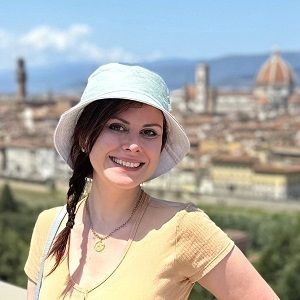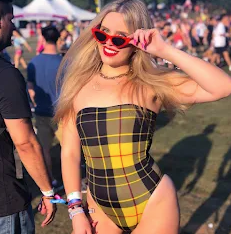Gyeongbokgung Palace: Tickets and Tours
Gyeongbokgung Palace is a magnificent landmark of Korean history. The palace was built in 1395 at the beginning of the Joseon Dynasty when the country’s capital was moved from Kaesong to Seoul.
The imposing building still stands as the heart of Korea’s capital, reminding visitors of its harrowed past. Gyeongbokgung stands for “Greatly Blessed by Heaven” which reflects the years of complicated history that the building has faced.
Gyeongbokgung Palace is a magnificent landmark of Korean history. The palace was built in 1395 at the beginning of the Joseon Dynasty when the country’s capital was moved from Kaesong to Seoul.
The imposing building still stands as the heart of Korea’s capital, reminding visitors of its harrowed past. Gyeongbokgung stands for “Greatly Blessed by Heaven” which reflects the years of complicated history that the building has faced.

(0/24) checking Musement...
Gyeongbokgung Palace is a magnificent landmark of Korean history. The palace was built in 1395 at the beginning of the Joseon Dynasty when the country’s capital was moved from Kaesong to Seoul.
The imposing building still stands as the heart of Korea’s capital, reminding visitors of its harrowed past. Gyeongbokgung stands for “Greatly Blessed by Heaven” which reflects the years of complicated history that the building has faced.
Take a tour of the palace to become immersed in one of the most essential destinations of Korea.

Here's is all you need to know about Gyeongbokgung Palace, one of the most famous attractions in Seoul.
How much do Gyeongbokgung tickets cost?
Tickets to Gyeongbokgung Palace vary based on age, place of residence and style of dress. Adult locals between the ages of 25 and 64 can purchase a ticket for 3,000 won (US$3) per person. Foreign adults between the ages of 19 and 64 can also purchase a ticket for 3,000 won (US$3) per person.
Who is eligible for discounts?
Local adults between the ages of 25 and 64 who travel with a group of 10 or more people are eligible for a discounted ticket of 2,400 won (US$2) per person.
Residents of the nearby town of Jongno-gu are able to receive a 50% discount on all ticket prices.
Foreign adults between the ages of 19 and 64 who arrive with a group of 10 or more people are eligible for a discounted ticket of 2,400 won (US$2) per person.
Is it possible to visit for free?
Local children under the age of 24 and foreign children under the age of 18 are able to enter Gyeongbokgung Palace for free.
Visitors 65 years and older and traditional Hanbok wearers are also able to enter for free.
All visitors are eligible for free entry every last Wednesday of the month in honor of Culture Day.
Should you book in advance?
It is not necessary to purchase Gyeongbokgung Palace tickets in advance. You can easily pick them up at the box office, though online booking is also available for your convenience.
What are the best Gyeongbokgung Palace tours?
Gyeongbokgung Palace History Walking Tour
Book a guided walking tour of Gyeongbokgung Palace to learn about the fascinating history of the beautiful destination. On this 2-hour excursion, you will begin with a meetup at Gyeongbokgung station where you’ll join your tour guide for the day.
From there, you’ll head to the palace's main gate to admire the grounds and architecture. Your guide will share captivating stories from 1395 when the stately home was built until the present day.
You’ll learn all about the biggest palace created during the Joseon Dynasty. Enjoy plenty of free time to roam and take photos where kings and queens once stood. Marvel at the pristine Gyeonghoiru pavilion that overlooks a man-made lake before closing out your tour.
Gyeongbokgung Palace Hanbok Rental Experience
This unique tour of Gyeongbokgung Palace allows you to step back in time and experience the Korean castle like Joseon-era royalty.
Arrive at the palace and enjoy skip-the-line access to enter the exhibit. Once inside, you’ll head to the Hanbok rental area to choose your traditional Hanbok.
Learn about Korean culture as you choose between 15 different options of formal attire and receive a hair transformation from the staff. Once you’re dressed, you can pose for photos in the colorful garb and explore the palace at your leisure in your Hanbok.
Choose a rental duration between 1.5 and 4 hours to fit your schedule. After your self-guided tour is complete, you’ll return your Hanbok to close out the day.
Are there any combined tickets or tours including Gyeongbokgung Palace and other attractions?
Gyeongbokgung Palace Tour plus Jogyesa Buddhist Temple

This full-day combination tour in Seoul is the perfect opportunity to discover both the history and culture of South Korea. Begin with an early morning pickup from your hotel in a comfortable coach vehicle.
Along the way, your professional guide will tell you all about the city of Seoul and its rich past. You’ll pass by the dignified Blue House — the home of the President of the Republic of Korea — before your first stop at Jogyesa Buddhist Temple. This 500-year-old holy place is the chief temple of the Jogye Order of Korean Buddhism.
Afterward, you’ll head to Gyeongbokgung Palace, the grand estate that has been ruined and rebuilt several times over its nearly 1000-year history. Afterward, you’ll head to the National Folk Museum of Korea where you’ll learn about Confucianism in Korean culture.
Stop for some shopping in Seoul before arriving at Insadong Antique Alley to browse traditional Korean shops and tea houses. Finish this full-day extravaganza with a visit to the UNESCO World Heritage Site Changdeokgung Palace and the Namdaemun Market before hotel drop-off.
Gyeongbokgung Palace plus The Painters Show
This exciting Gyeongbokgung Palace combination tour begins in Bukchon Hanok Village where you’ll peruse the Samcheong-dong Cafe Street with your experienced guide. Enjoy light refreshments before heading to Gyeongbokgung Palace where you’ll learn about the dynastic kings that roamed the halls in the 14th century.
You’ll also have the chance to visit Cheongwadae or The Blue House, the official residence of the President of South Korea. Finish with the awe-inspiring Painters Show, a live art performance that combines colorful live art with media technology.
Gyeongbokgung Palace plus Demilitarized Zone

On this tour of Gyeongbokgung Palace, you’ll also have the rare opportunity to take a peek at the Demilitarized Zone that separates North and South Korea. This day trip begins with a hotel pickup in a shuttle vehicle with a military tourist guide who will teach you about the history of the Korean War.
From there, you will see the Third Tunnel Experience which was originally created in order to invade South Korea with tanks. You’ll stop by an observatory where you can see first-hand North Korean residents and the war history pavilion. Experience all the mysteries of the DMZ including a stop at Imjingak Resort. Finish the day with a visit to Gyeongbok Palace.
What will you see inside?
Changing of the guards
One of the most popular attractions at Gyeongbokgung Palace is the changing of the guards. The ceremony takes place every open day at 10 AM and 3 PM. This tradition has taken place for centuries and remains an important historical custom to this day. The 10-minute experience features colorfully clad guards and their bright banners.
Gyeonghoeru Pavillion
Gyeonghoeru Pavilion is considered one of the most beautiful pieces of Gyeongbokgung Palace. The building is an ancient banquet hall that was once used by foreign visitors to the royal family. The two-story pavilion is surrounded by lush trees and overlooks a pristine man-made lake.
The National Folk Museum of Korea
The National Folk Museum of Korea is one of the museums that reside on Gyeongbokgung Palace grounds. The exhibition is filled with relics from Korean folklore and many fun interactive exhibits for children to enjoy.
How to get there?
You can get to Gyeongbokgung Palace by subway, bus or walking. From Seoul, you can take subway line 3 to Gyeongbokgung Station or subway line 5 to Gwanghwamun Station. After a short walk from either you’ll arrive at the palace. There are dozens of optional bus routes to choose from all around Seoul. If you’re on the North side of the Hangang River in Seoul a walk to the palace takes about 30 minutes.
What are the opening times?
Gyeongokgung Palace is open every week from Wednesday until Monday. The palace is closed on Tuesdays unless it coincides with a public holiday in which case the palace will remain open. If so, the first non-holiday after will be a closed day.
From January to February, the palace is open from 9 AM until 5 PM with the last entry at 4 PM. From March to May, the exhibit will be open from 9 AM until 6 PM with the last entry at 5 PM. From June to August, the palace is open from 9 AM until 6:30 PM with the last entry at 5:30 PM.
From September to October, the grounds are open from 9 AM until 6 PM with the last entry at 5 PM. From November to December, the palace is open from 9 AM to 5 PM with the last entry at 4 PM. All opening and closing times are subject to change.
Is it wheelchair friendly?
Gyeongbokgung Palace is wheelchair friendly with ramps built into the walls, ledges and across steps throughout the entire grounds.
When is the best time to visit the Gyeongbokgung Palace?
The best time to visit Gyeongbokgung Palace in Seoul is from April to June, during spring time and, from September to November during fall. when the weather is mild and the vibrant cherry blossoms or autumn foliage enhance the palace's beauty. Aim for mornings to avoid crowds.
Which other attractions can be visited in Gyeongbokgung Palace?
Travel tips
- Join a guided tour to gain insights into the historical and cultural significance of the palace.
- Wear modest clothing, as the palace is a revered cultural site.
- Be considerate of others and adhere to designated photo spots to preserve the experience for everyone.

